An Investigation into the Perceptions of Veterinarians towards Calf Welfare in New Zealand
Abstract
Simple Summary
Abstract
1. Introduction
2. Materials and Methods
2.1. Ethical Approval
2.2. Survey Development
2.3. Sampling
2.4. Data Analysis
3. Results
3.1. Demographic Data
3.2. Minimum Fitness for Transport (Age)
3.3. Maximum Time off Feed Prior to Slaughter
3.4. Maximum Transport Duration
3.5. Veterinary Concerns for Calf Welfare Compromise
3.6. Perceived Barriers to Welfare-Related Change
4. Discussion
4.1. Veterinary Perceptions towards Calf Welfare Legislation
4.2. Veterinary Concerns for Calf Welfare Compromise
4.3. Perceived Barriers to Welfare-Related Change
4.4. Limitations
4.5. Implications
5. Conclusions
Author Contributions
Funding
Institutional Review Board Statement
Data Availability Statement
Acknowledgments
Conflicts of Interest
Appendix A
| Code | Examples | Rank 1 | Rank 2 | Rank 3 | Total | WRS a |
|---|---|---|---|---|---|---|
| Disbudding | “Disbudding”; “Dehorning” | 11 | 10 | 8 | 29 | 61 |
| Castration | “Castration”; “Castration without analgesia” | 4 | 5 | - | 9 | 22 |
| Supernumerary teat removal | “Extra teat removal” | - | - | 2 | 2 | 2 |
| Ear tagging | “Ear tagging causes pain in calves” | - | 1 | - | 1 | 2 |
| Gastrointestinal disease | “Scours”; “Infectious scours” | 3 | 4 | 4 | 11 | 21 |
| Infection (unspecified) | “Disease” | - | 2 | 3 | 5 | 7 |
| Dystocia | “Survival at birth” | 2 | - | - | 2 | 6 |
| Transportation | “Trucking young calves to slaughter”; “Poor transport practices” | 15 | 16 | 8 | 39 | 85 |
| Inadequate housing | “Inadequate environments”; “Exposure to harsh conditions” | 8 | 16 | 10 | 34 | 66 |
| Mistreatment of “bobby” calves | “Treatment of bobby calves”; “Abuse of bobby calves” | 16 | 4 | 4 | 24 | 60 |
| Malnutrition | “Lack of food and water”; “Inadequate colostrum” | 9 | 6 | 16 | 31 | 55 |
| Inadequate pain management | “Lack of local anesthesia and analgesia” | 5 | 11 | 7 | 23 | 44 |
| Poor husbandry management | “On=farm management”; “Poor animal husbandry” | 5 | 7 | 6 | 18 | 35 |
| Maternal separation | “Age of removal from mother”; “Distress from removal from mother” | 6 | 1 | 3 | 10 | 23 |
| Limited knowledge | “Lack of training”; “Uneducated, untrained, and ill-equipped” | 5 | 1 | 3 | 9 | 20 |
| Stressful handling | “Poor handling” | 2 | 4 | 6 | 12 | 20 |
| Poor hygiene practices | “Disease control and hygiene practices” | 1 | 4 | 1 | 6 | 12 |
| Poor slaughter practices | “Slaughter methods” | 2 | 1 | 2 | 5 | 10 |
| Inadequate legislation | “New regs still not fully protecting calves” | 1 | 1 | - | 3 | 8 |
Appendix B
| Code | Examples | Rank 1 | Rank 2 | Rank 3 | Total | WRS a |
|---|---|---|---|---|---|---|
| Inadequate legislation | “Lack of welfare laws”; “Lack of monitoring of welfare” | 4 | 9 | 13 | 26 | 43 |
| Ingrained practices | “Accommodation to existing practice”; “Old-school farming”; “Tradition” | 19 | 14 | 4 | 37 | 89 |
| Resistance to change | “Resistance to changing current practice”; “Social inertia” | 14 | 8 | 7 | 29 | 65 |
| Lack of empathy | “Lack of concern”; “Lack of empathy among farmers” | 4 | 5 | 3 | 12 | 25 |
| Costs | “Price of analgesics”; “Costs of implementing change” | 21 | 29 | 18 | 68 | 139 |
| Practical limitations | “Increased labor demand”; “Time constraints” | 7 | 8 | 11 | 26 | 48 |
| Poor management | “Poor farming practices”; “Negligence” | 3 | - | 4 | 7 | 13 |
| Veterinarian communication | “Lack of courage among vets” | 2 | 1 | 3 | 6 | 10 |
| Limited knowledge | “Ignorance of poor welfare’; ‘Lack of education’ | 24 | 19 | 18 | 68 | 139 |
References
- Boulton, A.; Kells, N.; Beausoleil, N.; Cogger, N.; Johnson, C.; Palmer, A.; Laven, R.; O’Connor, C.; Webster, J. Bobby Calf Welfare across the Supply Chain—Final Report for Year 1; Technical Report: 2018/44; Ministry for Primary Industries: Wellington, New Zealand, 2018. [Google Scholar]
- Statistics New Zealand. Available online: http://nzdotstat.stats.govt.nz/wbos/index.aspx?datasetcode=tablecode7423 (accessed on 27 December 2020).
- Ministry for Primary Industries. Animal Welfare Regulations: Summary Report on Public Consultation April/May 2016; Ministry for Primary Industries: Wellington, New Zealand, 2017. [Google Scholar]
- Mellor, D. Bobby calf welfare. Surveillance 2000, 27, 6–8. [Google Scholar]
- Mee, J.F. Why Do So Many Calves Die on Modern Dairy Farms and What Can We Do about Calf Welfare in the Future? Animals 2013, 3, 1036–1057. [Google Scholar] [CrossRef]
- Rodriguez Ferrere, M.B.; King, M.; Larsen, L.M. Animal Welfare in New Zealand: Oversight, Compliance and Enforcement; The University of Otago: Otago, New Zealand, 2019. [Google Scholar]
- Sumner, C.L. Promoting Farmer and Veterinarian Cooperation to Improve Dairy Calf Welfare. Ph.D. Thesis, The University of British Columbia, Vancouver, BC, Canada, September 2018. [Google Scholar]
- Cuttance, E.L.; Mason, W.A.; Laven, R.A.; McDermott, J.; Phyn, C. Prevalence and calf-level risk factors for failure of passive transfer in dairy calves in New Zealand. N. Z. Vet. J. 2017, 65, 297–304. [Google Scholar] [CrossRef] [PubMed]
- Renaud, D.L.; Duffield, T.F.; LeBlanc, S.J.; Haley, D.B.; Kelton, D.F. Management practices for male calves on Canadian dairy farms. J. Dairy Sci. 2017, 100, 6862–6871. [Google Scholar] [CrossRef] [PubMed]
- Weary, D.M.; von Keyserlingk, M.A.G. Public concerns about dairy-cow welfare: How should the industry respond? Anim. Prod. Sci. 2017, 57, 1201–1209. [Google Scholar] [CrossRef]
- Farmwatch. Available online: https://vimeo.com/146749967 (accessed on 27 December 2020).
- Morris, M.C. The Use of Animals in New Zealand: Regulation and Practice. Soc. Anim. 2011, 19, 368–382. [Google Scholar] [CrossRef]
- Rodriguez Ferrere, M.B. Codes vs. regulations: How best to enforce animal welfare in New Zealand? Altern. Law J. 2018, 43, 250–256. [Google Scholar] [CrossRef]
- New Zealand Veterinary Association. NZVA position on Bobby Calf Welfare. Dairy Cattle Vet. Newsl. 2016, 33, 24–25. [Google Scholar]
- New Zealand Veterinary Association. Available online: https://www.nzva.org.nz/news/407325/NZVA-statement-The-Animal-Welfare-Act-must-protect-animals.htm (accessed on 27 January 2019).
- Derks, M.; van Werven, T.; Hogeveen, H.; Kremer, W.D.J. Veterinary herd health management programs on dairy farms in the Netherlands: Use, execution, and relations to farmer characteristics. J. Dairy Sci. 2013, 96, 1623–1637. [Google Scholar] [CrossRef] [PubMed]
- Pothmann, H.; Nechanitzky, K.; Sturmlechner, F.; Drillich, M. Consultancy to dairy farmers relating to animal health and herd health management on small- and medium-sized farms. J. Dairy Sci. 2014, 97, 851–860. [Google Scholar] [CrossRef]
- Kauppinen, T.; Vainio, A.; Valros, A.; Rita, H.; Vesala, K.M. Improving animal welfare: Qualitative and quantitative methodology in the study of farmers’ attitudes. Anim. Welf. 2010, 19, 523–536. [Google Scholar]
- Winder, C.B.; LeBlanc, S.J.; Haley, D.B.; Lissemore, K.D.; Godkin, M.A.; Duffield, T.F. Practices for the disbudding and dehorning of dairy calves by veterinarians and dairy producers in Ontario, Canada. J. Dairy Sci. 2016, 99, 10161–10173. [Google Scholar] [CrossRef]
- Wolf, C.A.; Tonsor, G.T.; McKendree, G.S.; Thomson, D.U.; Swanson, J.C. Public and farmer perceptions of dairy cattle welfare in the United States. J. Dairy Sci. 2016, 99, 5892–5903. [Google Scholar] [CrossRef]
- Laven, R.A.; Huxley, J.N.; Whay, H.R.; Stafford, K.J. Results of a survey of attitudes of dairy veterinarians in New Zealand regarding painful procedures and conditions in cattle. N. Z. Vet. J. 2009, 57, 215–220. [Google Scholar] [CrossRef] [PubMed]
- Fajt, V.R.; Wagner, S.A.; Norby, B. Analgesic drug administration and attitudes about analgesia in cattle among bovine practitioners in the United States. J. Am. Vet. Med. 2011, 238, 755–767. [Google Scholar] [CrossRef]
- Hewson, C.J.; Dohoo, I.R.; Lemke, K.A.; Barkema, H.W. Factors affecting Canadian veterinarians use of analgesics when dehorning beef and dairy calves. Can. Vet. J. 2007, 48, 1129–1136. [Google Scholar]
- Huxley, J.N.; Whay, H.R. Current attitudes of cattle practitioners to pain and the use of analgesics in cattle. Vet. Rec. 2006, 159, 662–668. [Google Scholar] [CrossRef] [PubMed]
- Bracke, M.B.M.; Edwards, S.A.; Engel, B.; Buist, W.G.; Algers, B. Expert opinion as ‘validation’ of risk assessment applied to calf welfare. Acta Vet. Scand. 2008, 50, 29. [Google Scholar] [CrossRef]
- Ventura, B.A.; Weary, D.M.; Giovanetti, A.S.; von Keyserlingk, M.A.G. Veterinary perspectives on cattle welfare challenges and solutions. Livest. Sci. 2016, 193, 95–102. [Google Scholar] [CrossRef]
- Lund, V.; Coleman, G.; Gunnarsson, S.; Appleby, M.C.; Karkinen, K. Animal welfare Science—Working at the interface between the natural and social sciences. Appl. Anim. Behav. Sci. 2006, 97, 37–49. [Google Scholar] [CrossRef]
- Thompson, C.S. 2016 Assessing Attitudes towards Welfare and Pain in Farm Animals. Ph.D. Thesis, The University of Edinburgh, Edinburgh, Scotland, November 2016. [Google Scholar]
- Bock, B.B.; van Huik, M.M. Animal welfare: The attitudes and behaviour of European pig farmers. Br. Food J. 2007, 109, 931–944. [Google Scholar] [CrossRef]
- Bracke, M.B.M.; Greef, K.H.D.; Hopster, H. Qualitative stakeholder analysis for the development of sustainable monitoring systems for farm animal welfare. J. Agric. Environ. Ethics 2005, 18, 27–56. [Google Scholar] [CrossRef][Green Version]
- Grethe, H. The Economics of Farm Animal Welfare. Annu. Rev. Resour. Econ. 2017, 9, 75–94. [Google Scholar] [CrossRef]
- White, S. Into the Void: International Law and the Protection of Animal Welfare. Glob. Policy 2013, 4, 391–398. [Google Scholar] [CrossRef]
- Barnett, J.L.; Hemsworth, P.H. Welfare Monitoring Schemes: Using Research to Safeguard Welfare of Animals on the Farm. J. Appl. Anim. Welf. Sci. 2009, 12, 114–131. [Google Scholar] [CrossRef]
- Whay, H.R. The journey to animal welfare improvement. Anim. Welf. 2007, 16, 117–122. [Google Scholar]
- Te Velde, H.; Aarts, N.; Van Woerkum, C. Dealing with ambivalence: Farmers’ and consumers’ perceptions of animal welfare in livestock breeding. J. Agric. Environ. Ethics 2002, 15, 203–219. [Google Scholar] [CrossRef]
- Millman, S.T.; Duncan, I.J.H.; Stauffacher, M.; Stookey, J.M. The impact of applied ethologists and the International Society for Applied Ethology in improving animal welfare. Appl. Anim. Behav. Sci. 2004, 86, 299–311. [Google Scholar] [CrossRef]
- Dillman, D.A. Mail and Internet Surveys: The Tailored Design Method, 2nd ed.; John Wiley and Sons: New York, NY, USA, 2000. [Google Scholar]
- Schwartzkopf-Genswein, K.S.; Booth-McLean, M.E.; Shah, M.A.; Entz, T.; Bach, S.J.; Mears, G.J.; Schaefer, A.L.; Cook, N.; Church, J.; McAllister, T.A. Effects of pre-haul management and transport duration on beef calf performance and welfare. Appl. Anim. Behav. Sci. 2007, 108, 12–30. [Google Scholar] [CrossRef]
- Goldhawk, C.; Janzen, E.; González, L.A.; Crowe, T.; Kastelic, J.; Pajor, E.; Schwartzkopf-Genswein, K.S. Trailer microclimate and calf welfare during fall-run transportation of beef calves in Alberta. J. Anim. Sci. 2014, 92, 5142–5154. [Google Scholar] [CrossRef]
- Jongman, E.C.; Butler, K.L. The Effect of Age, Stocking Density and Flooring during Transport on Welfare of Young Dairy Calves in Australia. Animals 2014, 4, 184–199. [Google Scholar] [CrossRef] [PubMed]
- Stafford, K.J.; Mellor, D.J.; Todd, S.E.; Gregory, N.G.; Bruce, R.A.; Ward, R.N. The physical state and plasma biochemical profile of young calves on arrival at a slaughter plant. N. Z. Vet. J. 2001, 49, 142–149. [Google Scholar] [CrossRef]
- Todd, S.E.; Mellor, D.J.; Stafford, K.J.; Gregor, N.G.; Bruce, R.A.; Ward, R.N. Effects of food withdrawal and transport on 5- to 10-day-old calves. Res. Vet. Sci. 2000, 68, 125–134. [Google Scholar] [CrossRef]
- Uetake, K.; Tanaka, T.; Sata, S. Effects of haul distance and stocking density on young suckling calves transported in Japan. Anim. Sci. J. 2011, 82, 587–590. [Google Scholar] [CrossRef]
- Earley, B.; Buckham Sporer, K.; Gupta, S. Invited review: Relationship between cattle transport, immunity and respiratory disease. Animal 2017, 11, 486–492. [Google Scholar] [CrossRef] [PubMed]
- Riondato, F.; D’Angelo, A.; Miniscalco, B.; Bellino, C.; Guglielmino, R. Effects of road transportation on lymphocyte subsets in calves. Vet. J. 2008, 175, 364–368. [Google Scholar] [CrossRef] [PubMed]
- Cave, J.G.; Callinan, A.P.L.; Woonton, W.K. Mortalities in bobby calves associated with long distance transport. Aust. Vet. J. 2005, 83, 82–84. [Google Scholar] [CrossRef] [PubMed]
- Fisher, A.D.; Colditz, I.G.; Lee, C.F. The influence of land transport on animal welfare in extensive farming systems. J. Vet. Behav. 2009, 4, 157–162. [Google Scholar] [CrossRef]
- Nielsen, B.L.; Dybkjær, L.; Herskin, M.S. Road transport of farm animals: Effects of journey duration on animal welfare. Animal 2011, 5, 415–427. [Google Scholar] [CrossRef]
- Cornish, A.R.; Caspar, G.L.; Collins, T.; Degeling, C.; Fawcett, A.; Fisher, A.D.; Freire, R.; Hazel, S.J.; Jennifer, H.; Johnson, A.J.; et al. Career Preferences and Opinions on Animal Welfare and Ethics: A Survey of Veterinary Students in Australia and New Zealand. J. Vet. Med. Educ. 2016, 43, 310–320. [Google Scholar] [CrossRef]
- Paul, E.S.; Podberscek, A.L. Veterinary education and students’ attitudes towards animal welfare. Vet. Rec. 2000, 146, 269–272. [Google Scholar] [CrossRef]
- Sabuncuoglu, N.; Coban, O. Attitudes of Turkish veterinarians towards animal welfare. Anim. Welf. 2008, 17, 27–33. [Google Scholar]
- Ellingsen, K.; Zanella, A.J.; Bjerkås, E.; Indrebø, A. The Relationship between Empathy, Perception of Pain and Attitudes toward Pets among Norwegian Dog Owners. Anthrozoös 2010, 23, 231–243. [Google Scholar] [CrossRef]
- Knight, S.; Vrij, A.; Cherryman, J.; Nunkoosing, K. Attitudes toward animal use and belief in animal mind. Anthrozoös 2004, 17, 43–62. [Google Scholar] [CrossRef]
- Levine, E.D.; Mills, D.S.; Houpt, K.A. Attitudes of Veterinary Students at One US College toward Factors Relating to Farm Animal Welfare. Anim. Welf. 2005, 32, 481–490. [Google Scholar] [CrossRef] [PubMed]
- Ostovic, M.; Mikus, T.; Pavicic, Z.; Matkovic, K.; Mesic, Z. Influence of socio-demographic and experiential factors on the attitudes of Croatian veterinary students towards farm animal welfare. Vet. Med. 2017, 62, 417–428. [Google Scholar] [CrossRef]
- Batchelor, C.E.M.; McKeegan, D.E.F. Survey of the frequency and perceived stressfulness of ethical dilemmas encountered in UK veterinary practice. Vet. Rec. 2012, 170, 19. [Google Scholar] [CrossRef] [PubMed]
- Pollard-Williams, S.; Doyle, R.E.; Freire, R. The influence of workplace learning on attitudes toward animal welfare in veterinary students. J. Vet. Medic. Educ. 2014, 41, 253–257. [Google Scholar] [CrossRef]
- Stull, C.; Reynolds, J. Calf Welfare. Vet. Clin. N. Am. Food Anim. 2008, 24, 191–203. [Google Scholar] [CrossRef]
- Adenkola, A.Y.; Ayo, J.O. Physiological and behavioural responses of livestock to road transportation stress: A review. Afr. J. Biotechnol. 2010, 9, 4845–4856. [Google Scholar]
- Mariti, C.; Pirrone, F.; Albertini, M.; Gazzano, A.; Diverio, S. Familiarity and Interest in Working with Livestock Decreases the Odds of Having Positive Attitudes towards Non-Human Animals and Their Welfare among Veterinary Students in Italy. Animals 2018, 8, 150. [Google Scholar] [CrossRef] [PubMed]
- Broom, D.M. The Qualities That Make Up Sentience. In Sentience and Animal Welfare; Broom, D.M., Ed.; CAB International: Oxfordshire, UK, 2010; pp. 1–6. [Google Scholar]
- Meijboom, F.L. More than just a vet? Professional integrity as an answer to the ethical challenges facing veterinarians in animal food production. Food Ethics 2018, 1, 209–220. [Google Scholar] [CrossRef]
- Grigor, P.N.; Cockram, M.S.; Steele, W.B.; Le Sueur, C.J.; Forsyth, R.E.; Guthrie, J.A.; Johnson, A.K.; Sandilands, V.; Reid, H.W.; Sinclair, C.; et al. Effects of space allowance during transport and duration of mid-journey lairage period on the physiological, behavioural and immunological responses of young calves during and after transport. Anim. Sci. 2001, 73, 341–360. [Google Scholar] [CrossRef]
- Knowles, T.G.; Warriss, P.D.; Brown, S.N.; Edwards, J.E.; Watkins, P.E.; Phillips, A.J. Effects on calves less than one month old of feeding or not feeding them during road transport of up to 24 hours. Vet. Rec. 1997, 140, 116–124. [Google Scholar] [CrossRef] [PubMed]
- Ministry for Primary Industries. Proposed Animal Welfare Regulations—Young Calves and Live Animal Exports; Ministry for Primary Industries: Wellington, New Zealand, 2016. [Google Scholar]
- Ventura, B.A.; von Keyserlingk, M.A.G.; Weary, D.M. Animal welfare concerns and values of stakeholders within the dairy industry. J. Agric. Environ. Ethics 2015, 28, 109–126. [Google Scholar] [CrossRef]
- Fraser, D. Assessing Animal Welfare: Different Philosophies, Different Scientific Approaches. Zoo Biol. 2009, 28, 507–518. [Google Scholar] [CrossRef]
- Vanhonacker, F.; Verbeke, W. Public and Consumer Policies for Higher Welfare Food Products: Challenges and Opportunities. J. Agric. Environ. Ethics 2014, 27, 153–171. [Google Scholar] [CrossRef]
- Hernandez, E.; Fawcett, A.; Brouwer, E.; Rau, J.; Turner, P.V. Speaking Up: Veterinary Ethical Responsibilities and Animal Welfare Issues in Everyday Practice. Animals 2018, 8, 15. [Google Scholar] [CrossRef]
- Rosenstock, I.M. The Health Belief Model and preventive health behaviour. Health Educ. Monogr. 1974, 2, 354–386. [Google Scholar] [CrossRef]
- Bran, J.A.; Daros, R.R.; von Keyserlingk, M.A.G.; Hötzel, M.J. Lameness on Brazilian pasture based dairies—Part 1: Farmers’ awareness and actions. Prev. Vet. Med. 2018, 157, 134–141. [Google Scholar] [CrossRef] [PubMed]
- Kristensen, E.; Jakobsen, E.B. Challenging the myth of the irrational dairy farmer; understanding decision-making related to herd health. N. Z. Vet. J. 2011, 59, 1–7. [Google Scholar] [CrossRef]
- Veterinary Council of New Zealand. The New Zealand Veterinary Workforce in 2017–2018; Veterinary Council of New Zealand: Wellington, New Zealand, 2018. [Google Scholar]
- Mellor, D.J.; Webster, J.R. Development of animal welfare understanding drives change in minimum welfare standards. Rev. Sci. Tech. 2014, 33, 121–130. [Google Scholar] [CrossRef] [PubMed]
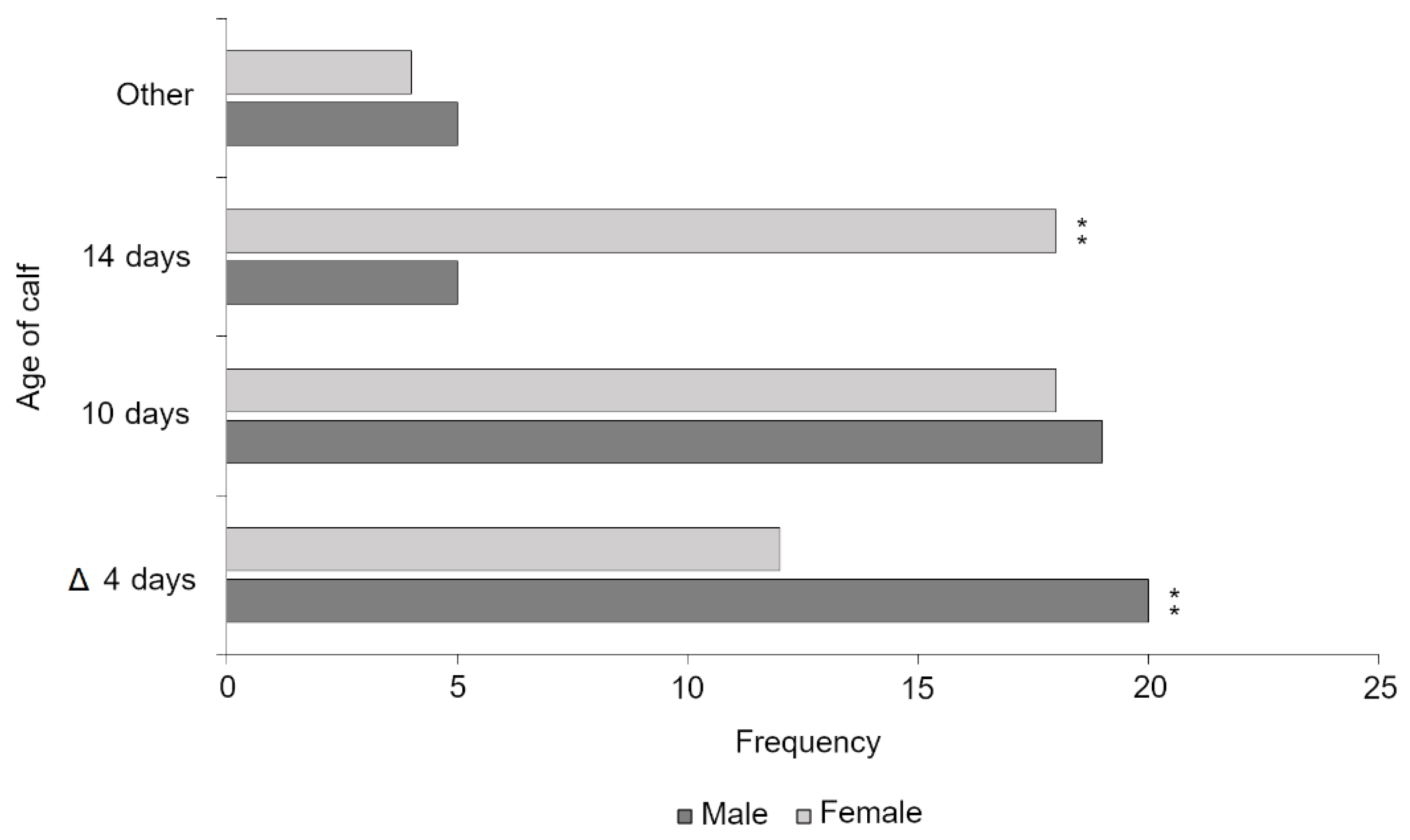
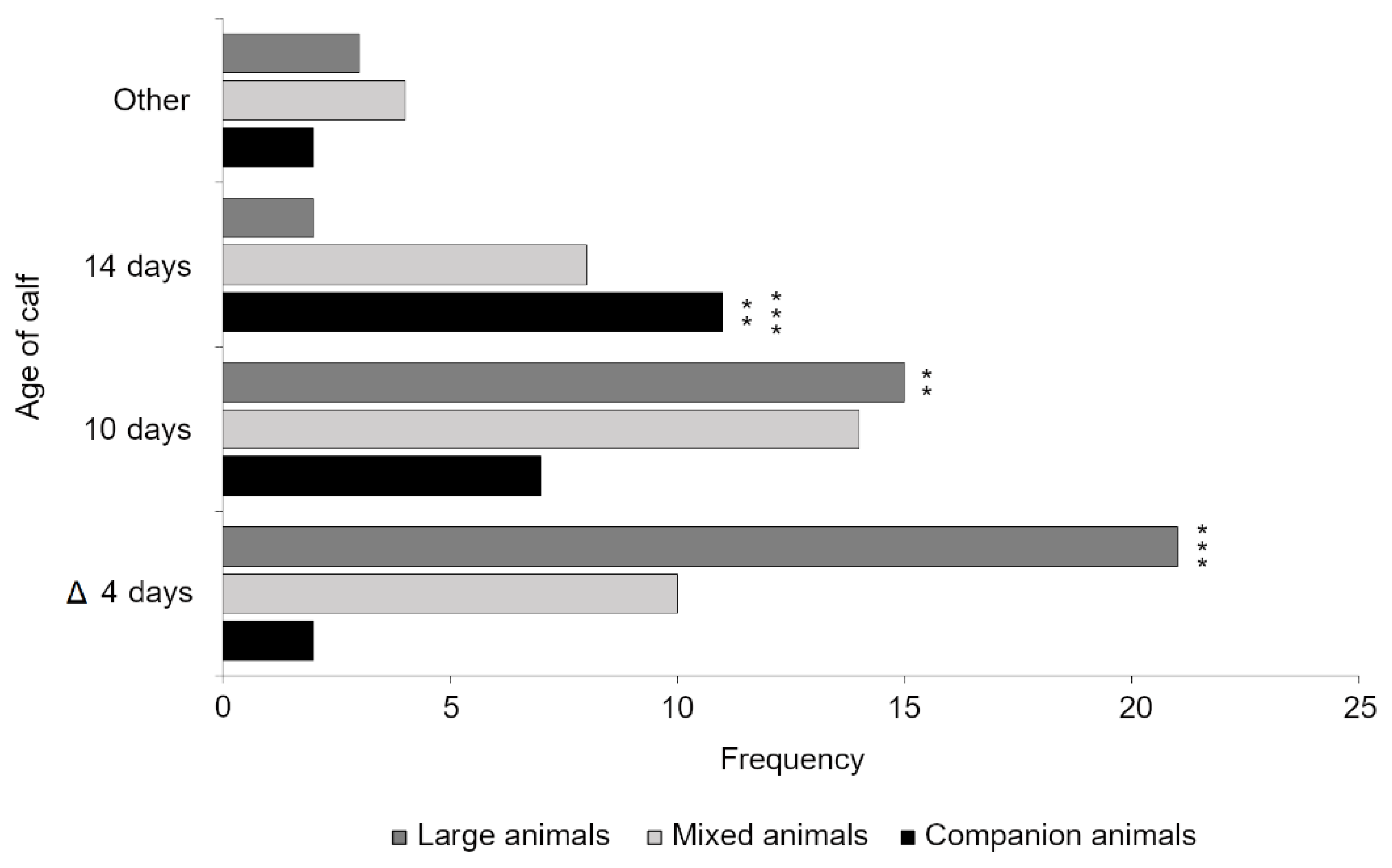
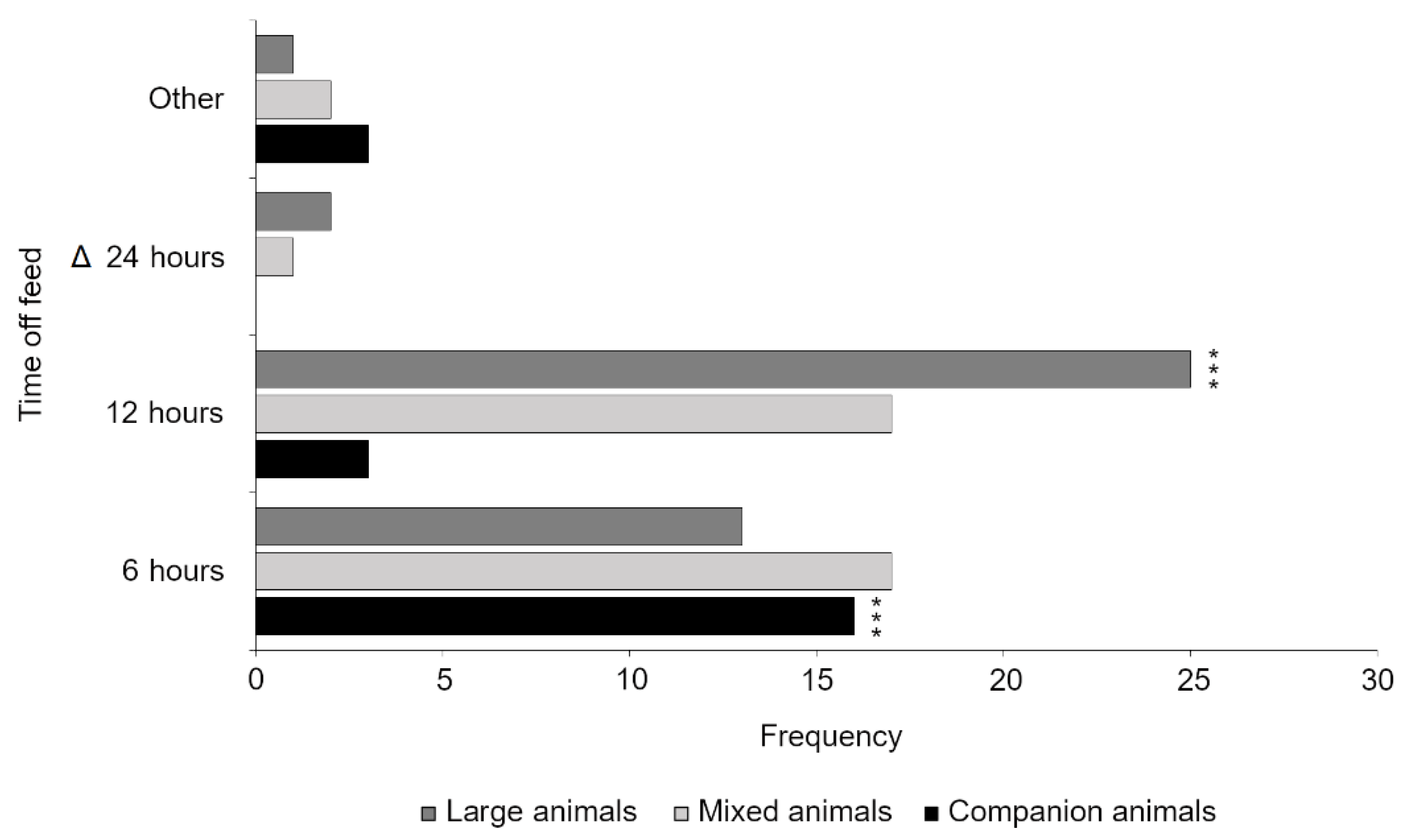
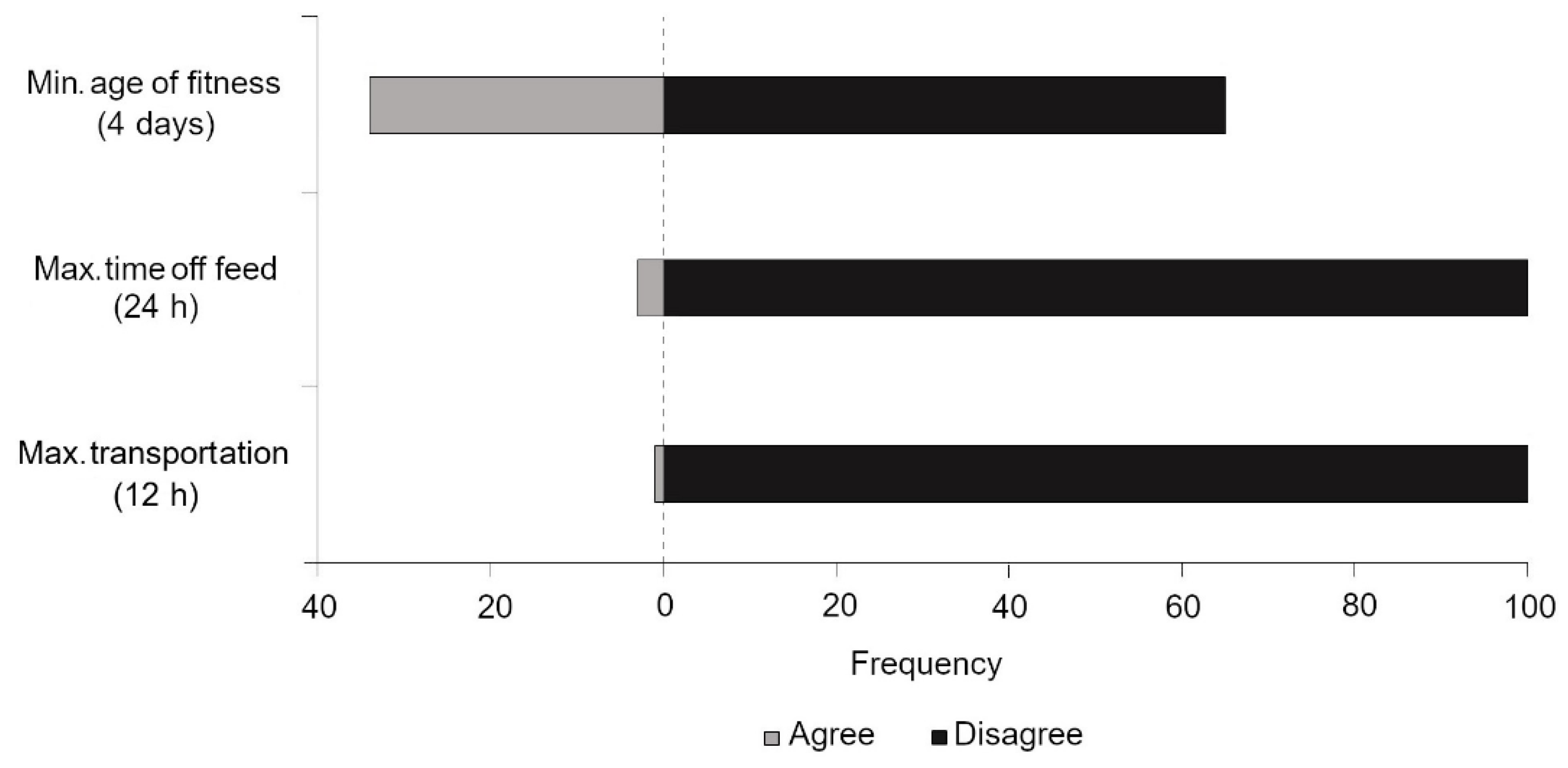
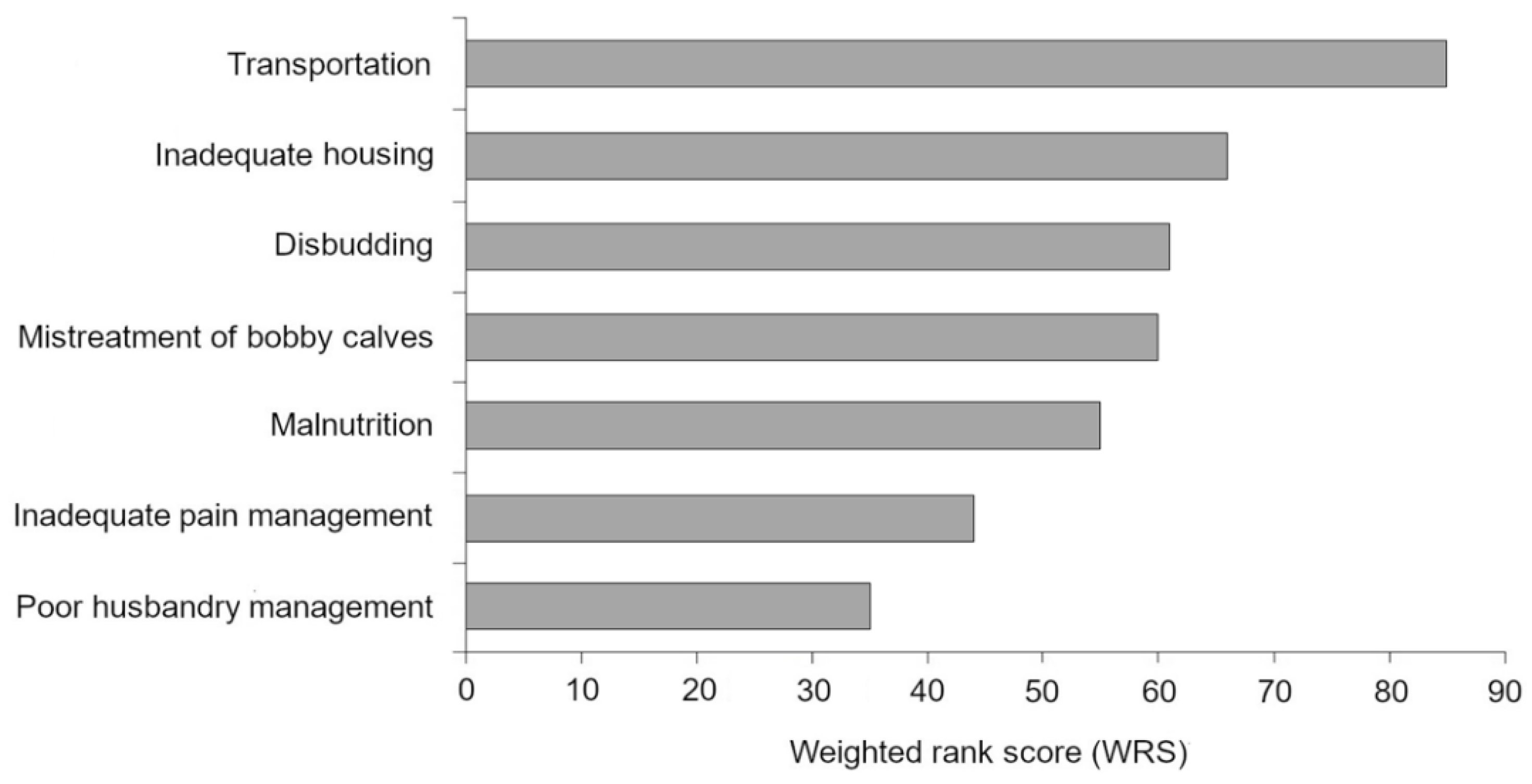
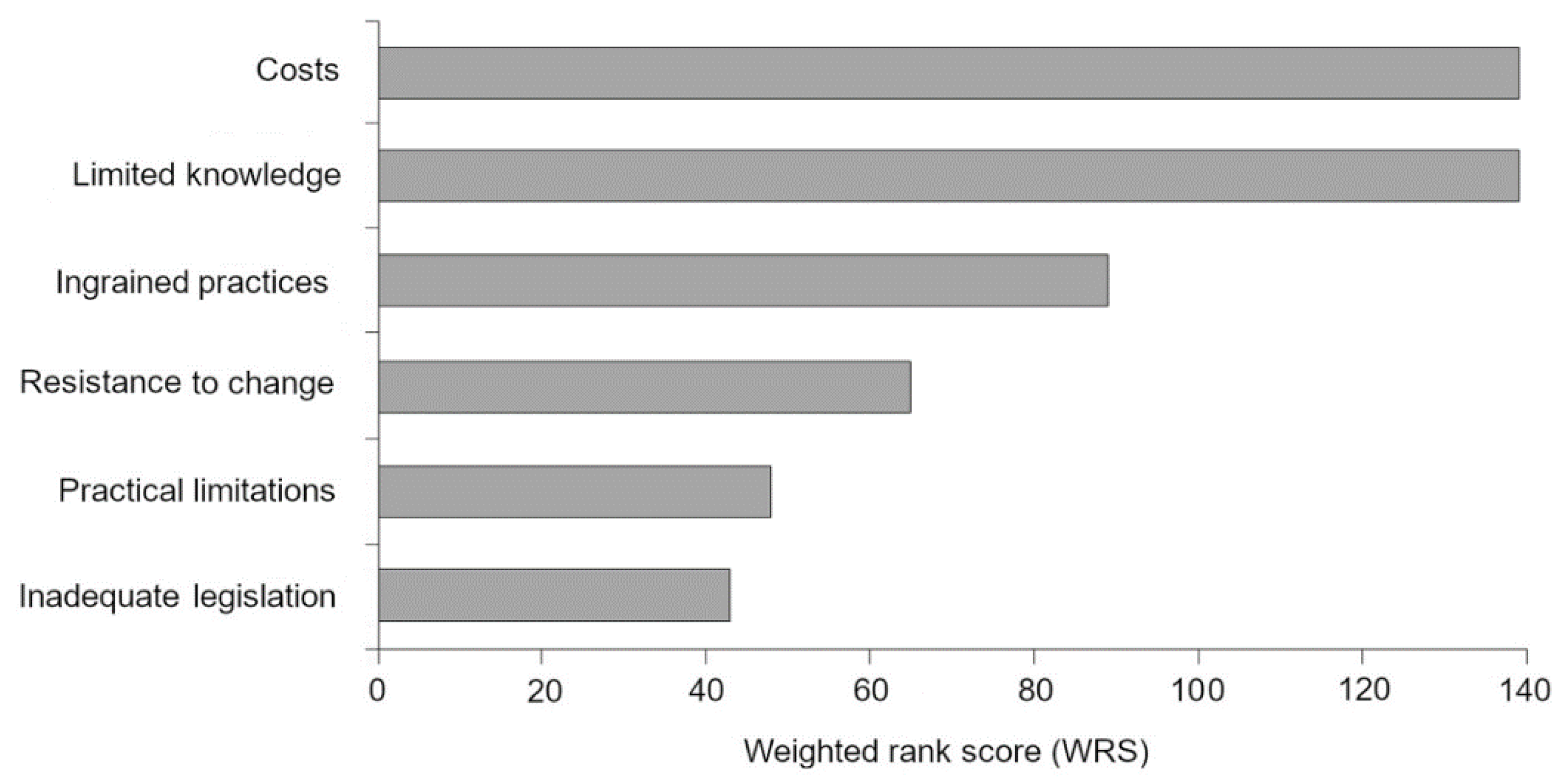
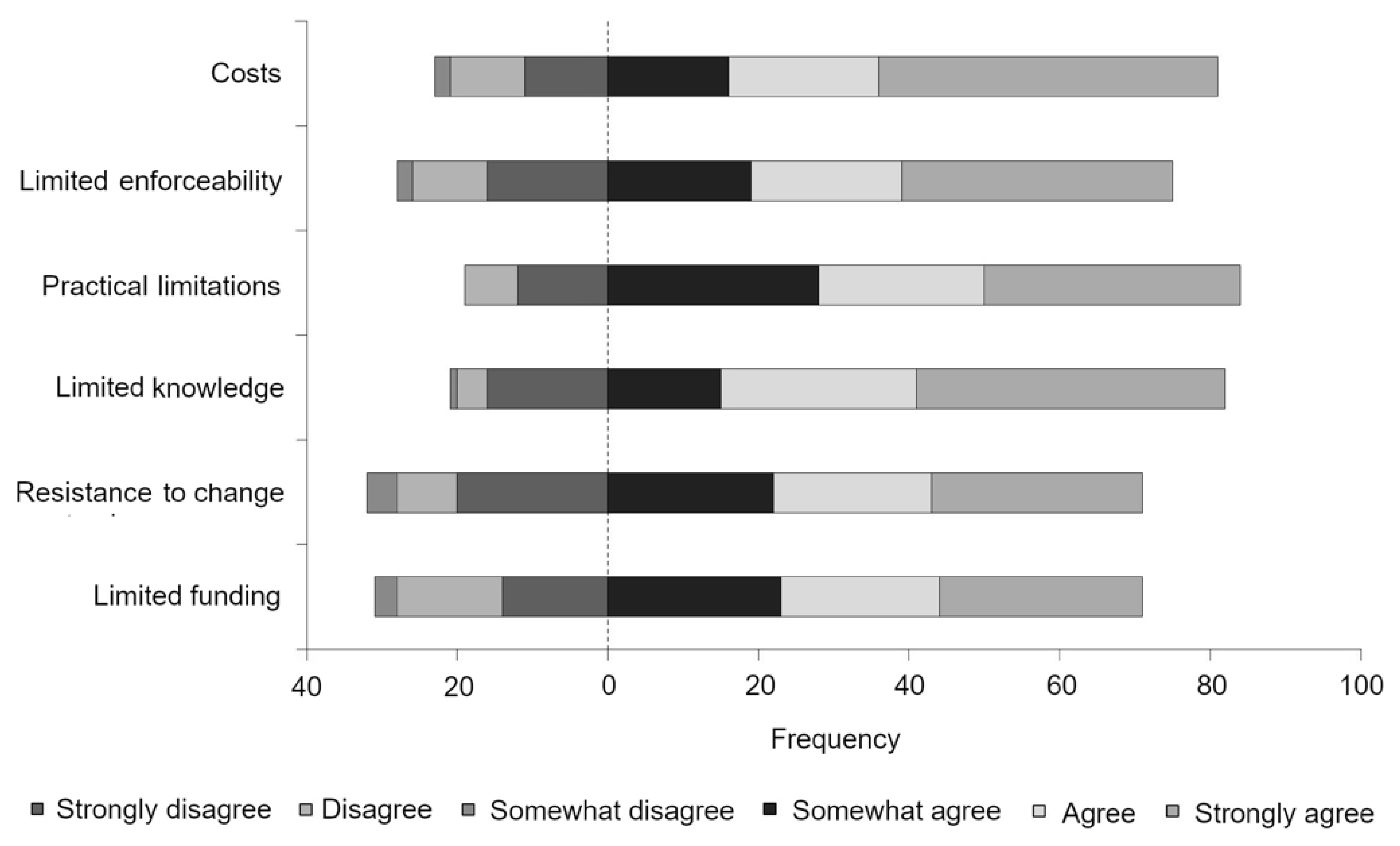
| Question Items | Response Options |
|---|---|
| In your opinion, what is the acceptable minimum age following birth that young calves are fit for transport? | 4 days, 10 days, 14 days, other (please specify) |
| In your opinion, what is the acceptable maximum time off feed for young calves prior to slaughter? | 6 h, 12 h, 24 h, other (please specify) |
| In your opinion, what is the acceptable maximum duration of transportation for young calves? | 6 h, 8 h, 10 h, 12 h, other (please specify) |
| Scale Items | Adapted from |
|---|---|
| An increase in costs associated with welfare-related change | [26,29,30,31] |
| Limited enforceability of animal welfare regulations | [13,26,32] |
| Practical limitations of monitoring animal welfare | [26,33,34] |
| Limited animal welfare knowledge among farm workers | [26,35] |
| Resistance to welfare-related changes among industry stakeholders | [29,35] |
| Limited funding to support welfare-related change | [26,34,36] |
| Demographic Variable | n | % |
|---|---|---|
| Years since graduation (N = 103; = 23.75; σ = 14.23) | ||
| 0–10 | 23 | 22.2 |
| 11–20 | 21 | 20.5 |
| 21–30 | 29 | 28.0 |
| 31–40 | 15 | 14.7 |
| 41 and over | 15 | 14.7 |
| Gender (N = 102) | ||
| Male | 49 | 48.0 |
| Female | 53 | 52.0 |
| Age (N = 103; = 48.75; σ = 13.92) | ||
| 24–30 | 12 | 11.6 |
| 31–40 | 21 | 20.2 |
| 41–50 | 23 | 22.2 |
| 51–60 | 25 | 24.1 |
| 61 and over | 22 | 21.4 |
| Species emphasis (N = 100) | ||
| Large animal practice | 41 | 41.0 |
| Mixed animal practice | 37 | 37.0 |
| Companion animal practice | 22 | 22.0 |
Publisher’s Note: MDPI stays neutral with regard to jurisdictional claims in published maps and institutional affiliations. |
© 2021 by the authors. Licensee MDPI, Basel, Switzerland. This article is an open access article distributed under the terms and conditions of the Creative Commons Attribution (CC BY) license (http://creativecommons.org/licenses/by/4.0/).
Share and Cite
van Dyke, R.; Miele, A.; Connor, M. An Investigation into the Perceptions of Veterinarians towards Calf Welfare in New Zealand. Animals 2021, 11, 421. https://doi.org/10.3390/ani11020421
van Dyke R, Miele A, Connor M. An Investigation into the Perceptions of Veterinarians towards Calf Welfare in New Zealand. Animals. 2021; 11(2):421. https://doi.org/10.3390/ani11020421
Chicago/Turabian Stylevan Dyke, Ria, Amy Miele, and Melanie Connor. 2021. "An Investigation into the Perceptions of Veterinarians towards Calf Welfare in New Zealand" Animals 11, no. 2: 421. https://doi.org/10.3390/ani11020421
APA Stylevan Dyke, R., Miele, A., & Connor, M. (2021). An Investigation into the Perceptions of Veterinarians towards Calf Welfare in New Zealand. Animals, 11(2), 421. https://doi.org/10.3390/ani11020421






